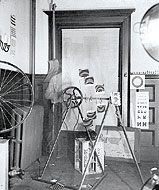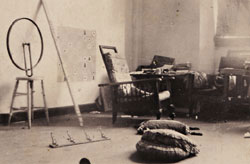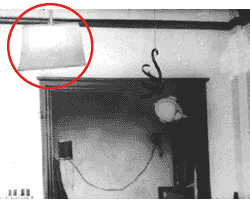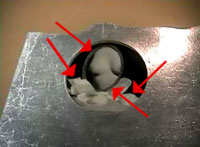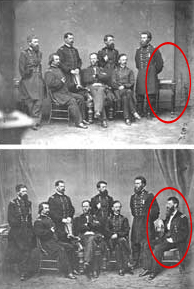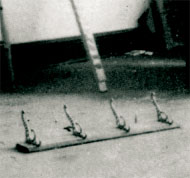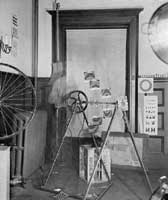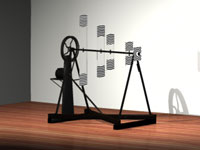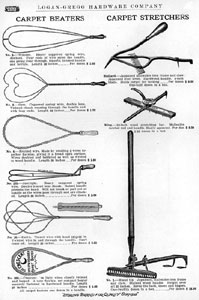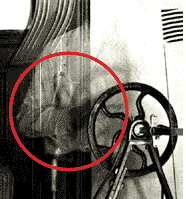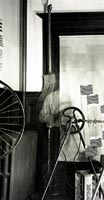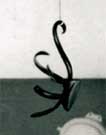|
Duchamp's readymade hatrack only
exists in the mind not
in factual nature.
After
duly noting the geometric distortions in Duchamp's six hatrack representations,
we must conclude that the simple history and definition of the hatrack
that everyone believed -- that a readymade is an unaltered, mass-produced
object -- must be completely reassessed and rewritten.
|
Click
to enlarge
|
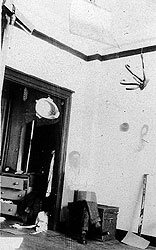 |
|
| Illustration
19A. |
Illustration
19B.
|
|
Studio
photograph (1916-17) with Duchamp's ghost image found in 1960's
© 2000 Succession Marcel Duchamp, ARS, N.Y./ADAGP, Paris
|
Photograph
of Duchamp's studio by Man Ray with Duchamp as ghost image, 1920
|
We can return to the
six representations of the hatrack and explore some of the issues now
raised such as to how Duchamp generated the six depictions? Did
he alter hatrack objects or doctor photographs or both? We are presently
working with forensic scientists to help us determine more about the
exact nature and type of photographic or physical manipulations that
Duchamp may have used. Duchamp, obviously, put us all on notice that
he was doing the photographic tricks well known in the late 19th and
early 20th century by both amateur and professional photographers, see
illustrations #19A, B. In both photographs 19A and B, Duchamp himself
appears to be a ghostly apparition, a typical photo trick of the time.(13)
|
Click
to enlarge
|
|
|
|
Illustration
20A.
|
|
Original
Studio Photograph, 1916-17
© 2000 Succession Marcel Duchamp, ARS, N.Y./ADAGP, Paris
|
Forensic experts that
I have consulted also noted that the scale, shadows and light directions
in many of Duchamp's photographs are inconsistent throughout the whole
image.(14)
As an example, strong shadows will, inconsistently, be cast from one
object but not from the other object directly next to it. (Closely examine
illustration 20A, Note that the stick leaning against the wall cast
a shadow and yet the Bicycle Wheel does not! Moreover, the pillows
in the foreground cast strong shadows and yet the Coatrack does
not!)
For another example,
look at illustration 20A, B and C. A full size snow shovel could not
possibly be hanging physically from a height indicated in these studio
photographs. We discover that the wood shaft would have to be too short
when we compare the shovel's size to the ceiling.
|
Click
all images to enlarge
|
|
|
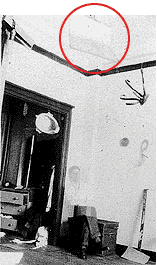 |
|
Illustration
20B.
|
Illustration
20C.
|
Photograph
of Duchamp's studio
used for making print for
the Box in a Valise, 1941
©
2000 Succession Marcel Duchamp,
ARS, N.Y./ADAGP, Paris
Note: circle is for clarity added by author
|
Note
that shovel could not be hanging at its full length from the ceiling.
Photograph of Duchamp's studio with Duchamp's ghost image, 1916-1917
© 2000 Succession Marcel Duchamp, ARS, N.Y./ADAGP, Paris
Note: circle is for clarity added by author
|
|
Click
to see video
|
|
|
|
Illustration
21A.
|
|
Marcel
Duchamp, In the Manner of Delvaux, 1942 © 2000 Succession
Marcel Duchamp, ARS, N.Y./ADAGP, Paris
Note: arrows are for clarity
added by author
|
|
Click
to enlarge
|
|
|
|
Illustration
21B.
|
|
Mathew
Brady used composite techniques in the earlist days of photography.
From Dino A. Brugioni, Photo Fakery: The History and Techniques
of Photographic Deception and Manipulation, Virginia: Brassey's,
1999, p. 34
Note: circles are for clarity
added by author
|
Our resulting hypothesis
must be that the shovel's wood shaft and handle have been somehow cut
off. Duchamp (or someone in his behalf) shortened the wood shaft either
physically or photographically. In the later case of trick photography,
instead of hanging a short snow shovel in his studio, Duchamp, or someone
at his behest, could have; 1); taken a photograph of a snow shovel and
carefully trimmed away the background; 2), Next, this snow shovel shaped
photograph part (with short wood shaft) would then be inset into a precisely
sized and shaped cut out receptacle in the studio photo's emulsion
|
Click
all images to enlarge
|
|
|
|
Illustration
22A.
|
|
Marcel
Duchamp, Trébuchet, 1917
|
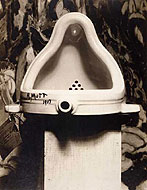 |
|
Illustration
22B.
|
|
Marcel
Duchamp, Fountain, photograph by Alfred stieglitz from
Blindman
No. 2, 1917
©
2000 Succession Marcel Duchamp, ARS, N.Y./ADAGP, Paris
|
(similar to putting
a cut out cookie back into its negative space within the rolled out
dough); 3), the studio background and shovel fragment now appear as
one photograph that is rephotographed and printed for the final resulting
composite that we see.
Examine here the video
of the work, In the Manner of Delvaux (1942) which documents only
one example among many of the expert skill Duchamp (or someone at his
request) demonstrated in creating photographic composites. (See Illustration
21A) Adding or subtracking subjects from photos was done with numerous
techniques from the earliest days of photography. Mathew Brady seamlessly
added an eighth Civil War general in illustration 21B.
The aforementioned
studio photographs (19A, B and 20A, B) present many other instances
of photographic manipulations that I will leave for future discussions.
However, please see Stephen Jay Gould's text box here to read his observations
and discovery regarding Duchamp's studio photograph, illustration 19B.
For now, I will limit myself to analysis of two studio photographs of
readymades to continue my argument (see illustrations 22A and 22B that
show Duchamp's "original" 1916 coatrack and "original" 1917
urinal.)
|
|
Did
Duchamp Give Us a Ghostly and
Partial Seventh Cut of His Hatrack?
Stephen
Jay Gould
|
Click
to enlarge
|
|
|
|
Photograph of Duchamp's studio by Man Ray, 1920
|
Man Ray's 1920
photograph of Duchamp's Rotative plaque de verre (with
one plate broken and scattered on the floor) raises many questions
that have never been addressed by art historians. In particular,
although the photo, at first glance, might seem to be a casual
snapshot of a messy studio, even a cursory examination reveals
complex changes, careful placements, and interpolations - particularly
to imbue the entire composition with a "circle" theme (understandable
since the centerpiece Rotatitive plaque is a device made
of glass rectangles that, when spun, produces the appearance of
a set of rotating circles.)
|
Click
to see video
|
|
|
|
Click
to see video
|
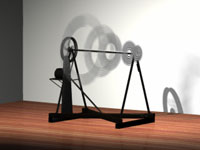 |
|
Animation
of the Rotary
Glass Discs in stationary position (top),
and in motion (bottom), 1920
|
But note all
the other circles, not so casually placed or imported into the
composition: the "target" beneath the chess pieces on the wainscotting,
the circle cut out of glass in front of the frame on the floor
next to the crate, the bicycle wheel to the left (but not resting
on the stool that should be visible if the famous readymade roue
de bicyclette just happened to be present in its reality and
entirety, and, especially, the blurred circular forms that look
like cooking pots with handles at the upper and lower right, and
that create such an interesting triangular composition with the
bicycle wheel at center left. (Thomas Girst suggests that these
large circles may be parts of the lighting equipment that Man
Ray set up to take the photo). One can go on ad infinitum:
why, in an otherwise complete chess set of white pieces on the
wainscotting, is a single pawn missing? Why is the Russian eye
chart hanging upside down?
|
Click
to enlarge
|
|
|
|
On
left, second example from the bottom matches carpet beater
Duchamp displayed.
Logan-Gregg Hardware Company, Pittsburg, 1912, p.
631
|
|
Click
to enlarge
|
|
|
|
Carpet
Beater like the one in Duchamp's studio photo from the ASRL
Collection.
|
But moving to
the main point of this note, look just to the left of the large
wheel at the left end of the rotative plaque. Here we see a ghost
figure of the top half of a man's body, perhaps Duchamp's. We
can hardly make out the head, but we see the right arm fairly
clearly, even including the creases of the shirt. The figure then
cuts off abruptly at the waist, but we can easily be fooled into
missing the cutoff because the photo includes what seems to be
an old-style carpet beater, business end pointing down and handle
pointing up, extending just where the man's right leg would be.
(Why?)
|
Click
to enlarge
|
|
|
|
See
Coatrack hook in photograph of Duchamp's studio by Man Ray
(detail), 1920
Note: circle added by author
|
Now, look above
the right forearm just behind the shirt cuff. The image is blurry,
but I'm fairly sure that I see a single full hook of a Thonet
hatrack (the presumed original for Duchamp's series of manipulations
and redoings). I originally thought that the ghost man was cradling
the hook in the crook of his arm. But I now think that the hook
just lies in front of the arm. The hook seems to be tied to a
string extending rigidly upwards and affixing nowhere. The hook
then curves around to the right, passing over the figure's arm,
and then completing its curve just under the arm and towards the
waist. A second string seems to emerge from the top, under the
first, and to run downwards and slightly to the left, finally
passing over the figure's arm just to the left of the hook itself.
|
Click
to enlarge
|
|
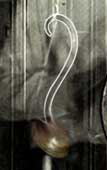 |
Outline surrounds ghostly hook. Wooden base added to illustrate
the position of this hook in an unaltered Thonet hatrack model
with three "S" shaped curves.
Note that string is tied to the top hook as in the two studio
photos below. |
|
Click
to enlarge
|
|
|
|
Photograph
of Duchamp's studio by Man Ray (detail), 1920
|
|
Click
to enlarge
|
|
|
|
1941
Photo
to make print for
Boite-en-valise (detail)
Note: String tied on the top hook
|
|
|
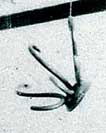 |
|
1916-1917
(found in 1960s)
Studio
Photo (detail)
Note: String tied to the top hook
|
Now, both Duchamp's
1941 Boite print of a 1916-17 studio photo and a second
studio photograph of the hatrack show the entire device hanging
from the ceiling, affixed by a similar string tied near the upper
end of a hook in positions comparable to the tie of the single
hook in the ghost photo. (Duchamp, by the way, produced several
photos with ghost images of himself emplaced into an interior
scene). However, one of the two studio photos of the "full" hatrack
in the 1941 Boite print seems to be missing one of the
three large hooks. Did Duchamp remove the hook from this photo
and then give it back to us as a single ghostly item in this later
photo? Hooking and roping us in yet again; pulling our leg with
his legless ghost; kicking us in the pants with a rug beater acting
as a surrogate for a leg?
|
|

